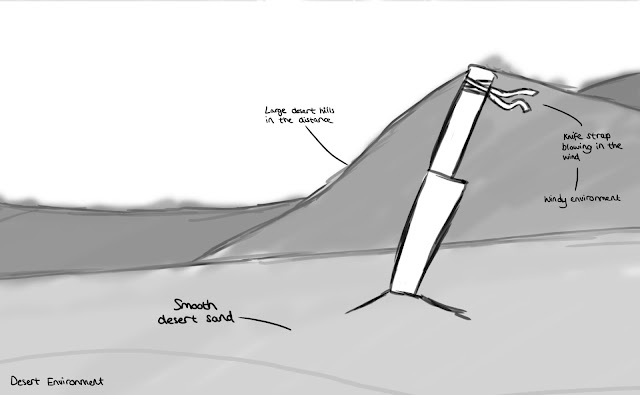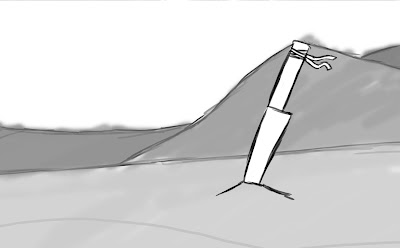For this document, I've sketched, toned, and coloured in the final design of my knife. I've annotated the different features of the knife such as the serrated blade edge, ridges in the handle and scratched metal textures.
Tuesday, 19 April 2016
Unit 9
Communication and Presentation survey.
This survey is to help you to understand the ways that you
have communicated on this course. This will show us what you think of these
ways of communicating and if we need to change anything in the coming
years. You can let us know what the
advantages and disadvantages of these were.
Please answer each question as fully as possible.
Verbal
presentation skills - In what ways have you verbally communicated your projects or
ideas during this year?
Group discussion around a table between peers, where we discussed our
ideas and received feedback afterwards.
What were the
difficulties in communicating in this way?
Trying to describe my ideas as best as possible to receive the best
feedback I can.
What were the advantages?
I was able to receive honest and accurate feedback from my peers and
tutor relating to my ideas so I could develop from them.
How do you think using these skills will help you in the
future when furthering your education or going into employment?
The skills I’ve gained from verbally communicating with my peers allow me
to easily describe my work in a way to receive the best feedback that I can, so
that I can start the development of my project.
Visual presentation skills - In what ways have you visually communicated your ideas
throughout your project?
I’ve prepared my work on my blog and allowed other peers to sit at my
computer and check out my work, whilst giving positive and constructive
criticism.
What were the difficulties?
The difficulties in this were that I had to neatly present my work in
order so it was easy for the viewer to give feedback on; I also had to choose
certain pieces of work depending on what I wanted them to see.
What were the advantages?
This allowed me to collect more feedback from my peers so I could
progress and develop my ideas.
How do you think using these skills will help you in the
future when furthering your education or going into employment?
The skills I've gained from visually communicating with my peers allow me
to see the advantages and disadvantages of a piece of work, so I can give
feedback on it.
Final exhibition - How do you plan to show your work at the final exhibition?
I plan to show my work at the final exhibition by setting out the development
of my project from day one; I will firstly show my initial ideas, and will
develop from there.
What other ways can you communicate to the exhibition
visitors who you are as a games student/artist so that they understand who you
are?
I have created a personalised business card on Photoshop based on myself
and my project.
How do you think using these skills will help you in the
future when furthering your education or going into employment?
These skills will allow me to use basic presentation skills in a work environment
in front of colleagues/peers.
Wednesday, 13 April 2016
For this document, I've sketched out three different knife shapes so I could get a rough idea of the shape of it so I can develop from there. I've also annotated the different features of each knife and spoken about my ideas regarding them all.
Sketches
For this sketch, my mind was set on tropical related environments, so I recreated Maya Bay in the Phi Phi Islands and drew the large rocks in the background for added effect. I then proceeded to sketch a knife (not finalised version) into the sand. Other features in the sketch include the ocean and waves, making the sketch more realistic. This sketch is one of the competitors but at this point, I was looking for something more basic/realistic.
For this sketch, I took into account my initial thoughts for this project and sketched it onto Photoshop. The end result is as shown above, which reflects my initial thoughts very well. I also took into account my recreation of the Far Cry 3 poster and sketched down my ideal setting. I included large sand hills in the background, along with wind physics to the leather strap, making it look more realistic. This is still my favourite idea as it reflects my initial thought process at the start of the project period.
For the final sketch, I decided to experiment with other environments. Immediately, my thought process was set on trees, so I sketched down a forest environment, with the knife standing up in the dirty, very much like the previous two sketches. The sketch contains very few features, but is still an idea regardless - I included a rough dirt terrain and lowered the wind physics on the leather strap. This idea could possibly be improved more but didn't appeal to me in the slightest, so I decided to look at our other two sketches...
After discussing my plans with my peers and tutors, I ended up planning my scene on the desert environment, purely because of the simplicity and realism of the idea. I will base my ideas and development up on the picture shown to the left - I will recreate, model, texture and render the image to my desired standard, and so it fits the merit criteria.
Tuesday, 12 April 2016
Mindmap
Here I've set out and labelled my rough ideas of the project so far. As you can see, I've labelled, the different types of knives, such as a bayonet, flip knife, machete, throwing knife etc. I've also labelled the different types of materials, specifically for the handle or for possible straps hanging from the knife. As well as this, I've labelled the different sizes and shapes for the knife to rule out unwanted ideas. For example, should the knife be big or small? Futuristic or vintage? These ideas are definitely something to take note of when drawing my ideas and actually creating the knife itself. In addition to this, I've written a few ideas involving the history of knives in general. For example, could the knife come from the Cavemen Era? The Egyptian Era? The Qijia Culture? These ideas could spawn a unique idea during the process so it's good to write down these things.
Reference Images
 |
| These are images of a beach that I personally captured in the Isle of Wight. They show in full detail the sand and the sky, which will serve as inspiration for when I go to model and texture in Maya. |
 |
| Knife Diagram |
Research on Knives
Knives are small yet dangerous weapons usually very sharp at
the tip of the blade. It consists of a handle, and the blade itself, however
knives used in the military have specific names, as they can hold gadgets and
tools. The typical kitchen knife, however, simply consists of a handle and a
blade. Knives go back thousands of years to the Egyptian era, when simple men
forged simple weaponry, ultimately creating a sharp blade to hunt with. Over
years, they have changed massively in shape, size, and threat, with the newer
military knives capable of penetrating human bone and slicing through raw
flesh. Although knives are simple weapons, they are commonly used in gang,
urban and modern warfare as a form of sidearm – they are typically used in
close combat, however highly trained users are capable of throwing them
accurately at a target. Knives have been a massive part of previous world wars,
such as World War 1 and 2, where it was clipped onto the end of rifles,
commonly the M1917 Enfield. They called this a ‘bayonet’. They produced these
through the 1910s to the 1930s, and then produced again in the 1960s.
Subscribe to:
Comments (Atom)










